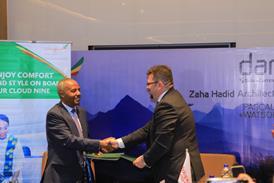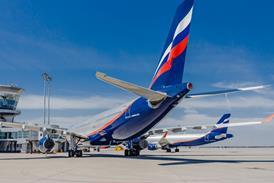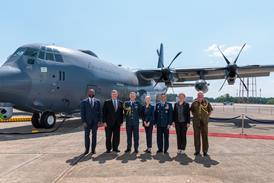Talking to R Lamar Durrett reveals his penchant for several key phrases. Structural change. Enhancing shareholder value. Tough business decisions. Core competencies. These words sum up much of what Durrett is trying to achieve at Air Canada, and reflect mid-1990s realities at many major airlines.
Durrett arrived in Montreal four years ago to join his long-time industry colleague and fellow Georgian Hollis Harris, who had been hired to rescue the carrier. A great deal has been achieved, but inevitably the goalposts have shifted in that time, and Durrett knows that plenty remains to be done if Air Canada's future prosperity is to be assured.
Air Canada lost over C$1 billion (US$800 million) between 1990 and 1993, but under Harris unit costs were slashed by 25 per cent and the carrier began to shake off the mentality and image of a bureaucratic, state-owned carrier. The airline has turned a profit in its last two full years, renewed much of its ageing fleet, expanded aggressively in the newly open US transborder markets, crossed the Pacific, and become a member of the alliance group led by United and Lufthansa.
Yet shareholders remain hostile, for a very good reason: Air Canada's financial performance remains anaemic, and the share price is well under half of its value when the carrier was privatised in 1988. In the first six months of this year, Air Canada suffered an operating loss of C$3 million (US$2.2 million), against a C$39 million operating profit in the same period in 1995. The carrier boosted its net result only through the C$129 million it gained by selling some of its stake in Continental Airlines.
Much of the blame for this poor operating performance rests with aggressive domestic competitors, who have cut yields dramatically. In the second quarter, Air Canada's domestic traffic jumped 8 per cent but revenues remained static.
In this interview, Durrett speaks of his strategy to improve Air Canada's financial performance. The easy cost savings have been achieved, he says, so now the carrier is aiming for further changes to the way it is organised, to produce lower unit costs despite slower growth. A substantial amount of debt is being paid down this year, improving the balance sheet and reducing interest costs.
Durrett dismisses analysts' suggestions that Air Canada will not be able to withstand the full force of US carrier competition when the protected transborder market from Toronto is opened up from February 1998, and he hints that Air Canada may reverse its strategy of avoiding the US fortress hubs. His decision to retain 15 DC-9s and six B747-200s suggests that Air Canada is ready to expand quickly should market conditions prove encouraging.
Inevitably, Durrett's appointment drew fire from the Canadian press, who bemoaned the fact that another American was going to be running Canada's largest airline. The southern roots of Durrett and Harris even led to Air Canada being compared to the Confederate Air Force.
There is no room for national pride in today's cut-throat airline business. He may not have been born in Canada, but Durrett has nearly 30 years of airline experience, mostly with Delta but also at Continental and the System One computer reservation system. With his background in human resources, engineering and information technology, Durrett should be well placed to find further cost savings. At the same time, he must complete Air Canada's transition from a sluggish state airline to a nimble entrepreneur.
Airline Business: What are your major priorities as president and CEO of Air Canada?
We have done the easier things to cut costs and improve productivity. We now need to make structural changes. This means changes in the way we do business.
For example, in Montreal we are combining our Mirabel and Dorval operations into one airport, Dorval, from April 1997. This will give us opportunities on both the revenue and cost sides.
We have also opened a new reservations centre in Saint John, New Brunswick, where there is not a huge airport, thereby giving us a stable workforce. Historically, our union contract has allowed a career path from reservations to the airport. This happens at the peak period each year. We then have to hire new reservations clerks, then there's five weeks of training, followed by the learning curve, so we have high cost and low efficiency.
Now another structural change, and one that I'm really enthusiastic about, concerns the International Association of Machinists (IAM), the union which represents our mechanics. A year and a half ago we entered into an agreement locally in Dorval to work together to come up with ways that would make Air Canada more productive, so that we could protect all of our jobs here, and be in a position to get more third party maintenance work.
Now, a lot of this was actually union driven, through what they call an HPWO initiative - High Performance Work Organisation. All up and down the line, we have formed management and union teams that are working together on various initiatives and on a lot of the daily decision making. I believe it has great potential. It's going to provide structural changes, and some of those are going to show up in 1997.
Another decision that we recently made was to take the B747 heavy maintenance checks out of Air Canada. Now that was an emotional situation. We have maintained that airplane for 25 years, and it hasn't been easy for our people to accept that change. But the bottom line is that that is not one of our core competencies [because the volume of work is insufficient]. What we're going to do now is concentrate where our strengths are, and that's in our engine shop and B767 and A320/A319.
None of our people are going to lose their jobs here because of that decision, in fact we're going add 160 new employees over the next year in the engine shop, because we have confidence in our competitiveness. In return for the B747 work leaving here [to Air France], we're going to take in some B767 work [from Air France]. It's a structural change that's going to take costs out of this airline and improve turn times, which will then add revenues to this airline.
Our financial planning for this year and the next several years includes paydown of our longterm debt, and we're going to have to fit aircraft acquisitions underneath the first priority, which is the debt repayments. That's one of our main thrusts to help our shareholder value.
We intend to keep our product in the marketplace competitive. I think a negative perception, especially by the financial analysts, is that in the open skies arena the US guys are going to come in waves when the caps are lifted off Toronto in February 1998. There's a feeling that we may not be able to withstand the competition. Our belief is that that is absolutely not true.
About 65 per cent of the passengers on the transborder are Canadian originators, and fortunately for us, Canadians by and large are loyal to their airlines. Also, since the US guys have been able to come up here in the last two years in numbers there has already been a retrenchment, as everybody learns what's there and what's not. I think the knowledge now is that this may not necessarily be the goose that lays the golden egg as far as the US airlines are concerned.
Most of all, the Air Canada product on the transborder is superior to the US carriers'. Our level of service is better, and we're going to keep it that way.
We opened 31 new US markets in 1995, and we're up now to 33. The markets are definitely maturing. We see this as a strong point for Air Canada, especially out of Toronto, because that's our major hub.
I believe as we demonstrate, both to the analysts and to the marketplace, that we're going to be the biggest force in Toronto, that's going to help our stock. The bottom line is that if we reduce our debt and continue to operate with net profit increases, the value of the stock will take care of itself.
Our original thrust was to stay out of the fortress hubs in the US and fly to the other mid-sized business markets on a nonstop basis. We have done that and it's been successful. But where we have gone to fortress hubs, like Toronto-Atlanta, the strength of our Toronto hub has helped us to be profitable. We also have been able to hold our own in St Louis against TWA. I don't think we necessarily are going to stay out of the fortress hubs. I think that's another area of possible growth for us.
We're going to continue to pick these markets carefully, and if it doesn't work for us, we're going to pull out. We pulled out of Montreal-Atlanta, Calgary-Denver and Vancouver-Denver. But our other services are working for us, markets like Toronto-Nashville. In November, we're going to open Raleigh-Durham out of Toronto.
China is going to be a big player, so we're very interested in that market. Right now, the international aviation policy of Canada states that you cannot have dual designation unless there are 300,000 commercial passengers, and of course China will meet that in time.
Hong Kong meets that threshold. The government of Canada will have to ask for a consultation which the bilateral permits because of material change, which is that Cathay Pacific has dramatically increased its services. It has frequencies that are twice the combination of Canada's two carriers'.
Look at our relationship with United. We're both flying the Chicago market out of Canada. We both codeshare. We've seen good benefit for both of us in that market. United's size in California alone is such that we obviously want to deal very closely with them in the Los Angeles and San Francisco marketplace.
In Europe, we're very strong in London, and we're also strong in Frankfurt, but beyond those two gateways a lot can be done, and Lufthansa of course has the power to make that happen. Vice-versa, we're already codesharing with Lufthansa from western Canada to Germany. In addition, this fall our main competitor is going to pull out of Frankfurt and Paris, and we can step in and fill some of that gap. When we look beyond to eastern Europe and Africa, Lufthansa can offer us a lot of strength.
If a bag turns up lost on the Air Canada system, where it was lost someplace else in the world, we've got to have the ability to own that problem. You can't say to the customer: 'Hey, our partner XY has lost this, you're going to have to go to them.' It's more difficult to accomplish than it sounds.
Source: Airline Business




















